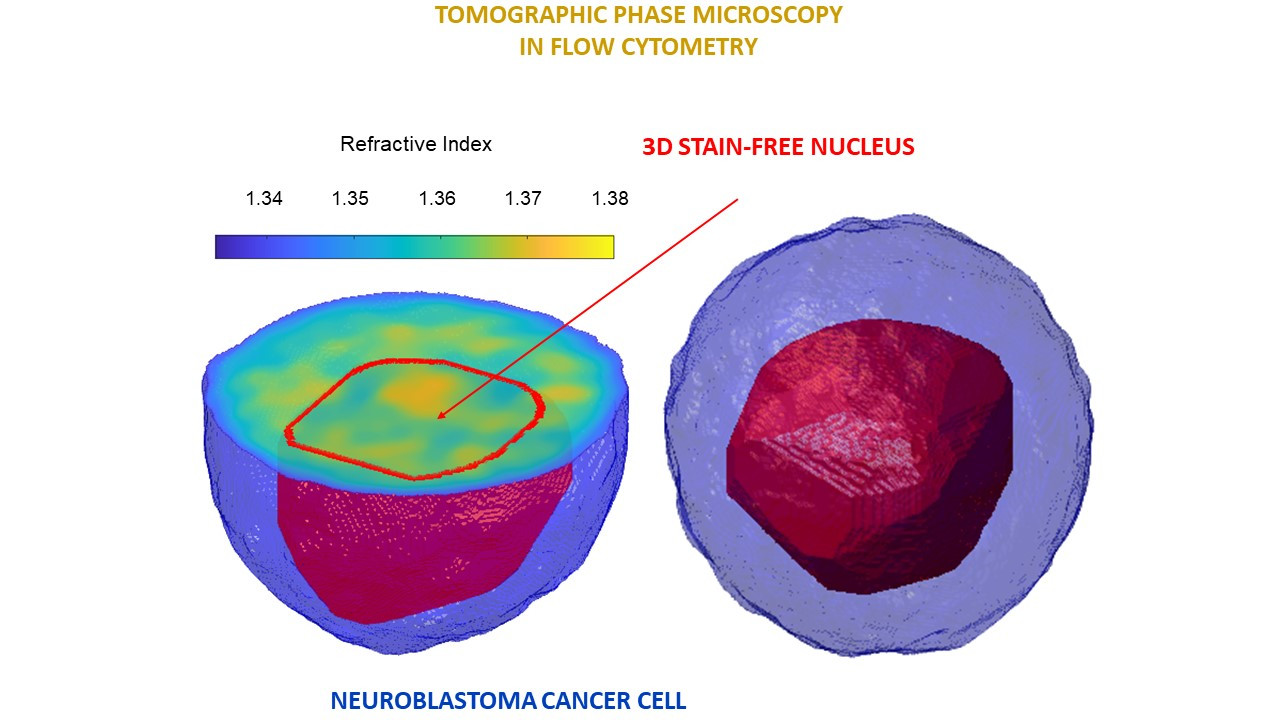
Cells in 3D: a new technique from microscopy
An international study, led by Italian researchers from Istituto di scienze applicate e sistemi intelligenti “E. Caianiello” of Consiglio nazionale delle ricerche, Università degli Studi di Napoli “Federico II” and CEINGE - Biotecnologie Avanzate Franco Salvatore, revealed the possibility of identifying, visualizing and measuring in 3D the nucleus of single cancer cells through advanced microscopy techniques without the use of chemical dyes. The study, published in Nature Photonics, opens up new avenues for cell biology applications.
Cells in 3D without the use of chemical dyes or marker antibodies: an international study, led by Italian researchers from Istituto di scienze applicate e sistemi intelligenti (Isasi) “E. Caianiello” of Consiglio nazionale delle ricerche (Cnr), Università degli Studi di Napoli “Federico II” and CEINGE - Biotecnologie Avanzate Franco Salvatore, has discovered the system to perform the CT scan of each single cell, distinguishing the healthy from the sick ones, without changing their structure and reducing the margin of error in the human interpretation of the data. It is an in-flow holographic tomography capable of measuring biophysical properties closely related to the state of the cell, obtained by computational techniques, which could establish a very significant breakthrough in the early diagnosis of tumors and in the experimentation of new drugs for therapeutic use.
The results of the research, published in the high-impact scientific journal Nature Photonics (Springer Nature Group) revealed the ability to identify, visualize and measure in 3D the nucleus of single cancer cells through advanced microscopy techniques without the use of chemical dyes thus opening up completely new avenues for cell biology studies. This is expected in the future to lead to new opportunities in the clinic of diseases caused by molecular alterations. In fact, the 3D holographic technology behind the obtained results could revolutionize flow cytometry, currently based on 2D fluorescence imaging. The latter is, in fact, limited by the staining process necessary to identify intracellular structures, takes a long time and alters their cellular properties.
"The most promising application of flow cytometry based on phase contrast tomography is liquid biopsy, the least invasive investigation currently feasible, which aims at the early diagnosis of tumors and the definition of personalized oncological therapies", explains Achille Iolascon, Professor of Medical Genetics at Federico II and Principal Investigator CEINGE. "The method of identification of single tumor cells developed in this study opens up the possibility of activating new research lines to develop techniques capable of monitoring and extracting the tumor cells that circulate in the patient's blood", adds Mario Capasso, professor of Medical Genetics of Federico II and Principal Investigator CEINGE.
The Italian team that carried out the research and which includes physicists, engineers, geneticists and biotechnologists was enriched by the international collaboration of Swiss researchers from the Optics Laboratory of the Ecole Polytechnique Fédérale de Lausanne (EPFL) directed by Professor Demetri Psaltis.
The study focused on the nucleus of cancer cells which, among the various organelles, is the one that contains most of the genetic material and is responsible for the lifecycle of the cell. Identifying the nucleus in unlabeled cells is a huge challenge to which various groups around the world have been trying to give solutions in recent years by means of artificial intelligence but without obtaining results in flow cytometry. "For this purpose, we have designed and developed a new methodology, pending patent, based on a purely computational statistical approach capable of obtaining the nucleus from each single flowing cell" remark Daniele Pirone and Pasquale Memmolo, respectively research fellow and senior researcher at CNR-Isasi.
"The 3D nature of phase contrast tomography in flow cytometry mode has the ability to measure the biophysical properties closely related to the state of the cell," says Lisa Miccio, who contributed to the development of the Holographic Flow Tomography system at the Cnr-Isasi labs. In addition, Holographic Flow Tomography, thanks to the absence of chemical dyes, represents a real technological breakthrough compared to conventional flow cytometry. "In fact, the results published in the Nature Photonics journal, open new scenarios and research to identify further unlabeled intracellular organelles and the development of low-cost portable systems "lab-on-chip" scale, prospecting the implementation of personalized medicine based on the non-invasive analysis of single cells in biological fluids (blood, urine, saliva, etc.)", concludes Pietro Ferraro (Cnr-Isasi), national coordinator of the Project of Relevant National Interest by the Italian Ministry of University and Research (PRIN 2017N7R2CJ named MORFEO-Morphological Biomarkers for early diagnosis in Oncology) which funded the research.
